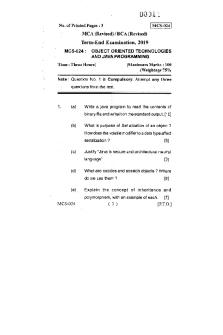Jan 2019 N1589 - Past paper PDF

| Title | Jan 2019 N1589 - Past paper |
|---|---|
| Course | International Entrepreneurship |
| Institution | University of Sussex |
| Pages | 2 |
| File Size | 68.7 KB |
| File Type | |
| Total Downloads | 75 |
| Total Views | 136 |
Summary
Past paper...
Description
Candidate Number
N1589
THE UNIVERSITY OF SUSSEX BSc SECOND YEAR EXAMINATION
Introduction to Entrepreneurship Assessment Period: January 2019 (A1)
DO NOT TURN OVER UNTIL INSTRUCTED TO BY THE LEAD INVIGILATOR Candidates must attempt all questions Duration: 2 hours OPEN EXAM Candidates should bring their annotated paper copies of the case study; ‘Women entrepreneurship and challenges in India: The case of Avika’. Students are not permitted to bring any other materials. At the end of the examination the question paper and any answer books/answer sheets, used or unused, will be collected from you before you leave the examination room.
N1589
Introduction to Entrepreneurship
1.
What are the reasons why people become entrepreneurs? What were Malavika Sharma’s motivations for starting Avika? Critically evaluate the distinction between pull and push theory of entrepreneurial motivations. [20 marks]
2.
Malavika states that she is an accidental social entrepreneur. Critically evaluate the usefulness of trait theory in predicting who will become an entrepreneur. Discuss the role of social process and environmental factors on entrepreneurs. [20 marks]
3.
In the process of creating Avika, did Malavika follow an effectual or causal process? Critically discuss the five principles associated with effectual thinking in relation to Malavika and Avika? [20 marks]
4.
In what ways have the contexts, rural setting and social-cultural norms, influenced the venture development process and Malavika’s life as an entrepreneur? Were these challenges specific to a venture led by women and run for women? [20 marks]
5.
Avika was formed as a social enterprise. Identify some of the characteristics of Avika in relation to social enterprises. Compare and contrast social and commercial enterprises in terms of mission/purpose, beneficiaries, performance measurement, and triple bottom-line values. [20 marks]
END OF PAPER
2...
Similar Free PDFs

Jan 2019 N1589 - Past paper
- 2 Pages

Jan 2019 Paper
- 32 Pages

ANAT2004 2019 past paper
- 16 Pages

SBL Past Exam Paper 2019
- 20 Pages

Jan 2019 (Done) - Practice
- 9 Pages

ELX303 Jan 2019 Exam
- 8 Pages

SFM JAN 21 Paper Analysis
- 46 Pages

Uob past paper
- 4 Pages

Legal Studies Past paper
- 18 Pages

STAT270 - past exam paper
- 24 Pages

Dec 2019-Jan 2020 Solved
- 8 Pages

SCH4U Exam Review Jan 2019
- 3 Pages
Popular Institutions
- Tinajero National High School - Annex
- Politeknik Caltex Riau
- Yokohama City University
- SGT University
- University of Al-Qadisiyah
- Divine Word College of Vigan
- Techniek College Rotterdam
- Universidade de Santiago
- Universiti Teknologi MARA Cawangan Johor Kampus Pasir Gudang
- Poltekkes Kemenkes Yogyakarta
- Baguio City National High School
- Colegio san marcos
- preparatoria uno
- Centro de Bachillerato Tecnológico Industrial y de Servicios No. 107
- Dalian Maritime University
- Quang Trung Secondary School
- Colegio Tecnológico en Informática
- Corporación Regional de Educación Superior
- Grupo CEDVA
- Dar Al Uloom University
- Centro de Estudios Preuniversitarios de la Universidad Nacional de Ingeniería
- 上智大学
- Aakash International School, Nuna Majara
- San Felipe Neri Catholic School
- Kang Chiao International School - New Taipei City
- Misamis Occidental National High School
- Institución Educativa Escuela Normal Juan Ladrilleros
- Kolehiyo ng Pantukan
- Batanes State College
- Instituto Continental
- Sekolah Menengah Kejuruan Kesehatan Kaltara (Tarakan)
- Colegio de La Inmaculada Concepcion - Cebu



